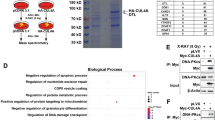Abstract
In a previous study, we elucidated the apoptotic mechanism mediated via Fas/FasL-dependent pathway in mitomycin C-treated cervical carcinoma cells. In this study, 2-D and MALDI-TOF analyses were performed in order to search mitomycin C-induced modulators in cervical carcinoma cells. Some protein spots down- or up-regulated by mitomycin C were separately selected from the 2-D gels. Twenty protein spots were identified from the 2-D gels. Among the 20 spots, 11 spots were down-regulated, whereas 9 spots were up-regulated in SiHa/pRSV-luc cells by mitomycin C. Three spots have not been identified in the database. Ku70-binding protein (KUB3), MHC class I antigen, MHC class I chain-related protein A or multi-PDZ domain protein 1, MAGUK P55 subfamily member 3 or lamda/iota protein kinase C-interacting protein, and GL014 or Sad1/unc-84 protein-like 1 were suppressed by mitomycin C treatment. Heat shock 60 kDa protein 1 (chaperonin), similar to heat shock protein 90 kDa protein alpha or ninein centrosomal protein isoform C, NADP-dependent malic enzyme, mitochondrial precursor, GRB10 adaptor protein, glycogenin-interacting protein 1, cystathionine gamma-lyase, G2/mitotic-specific cyclin B2 or heat shock 90 kDa protein 1 alpha, peptidyl-prolyl cis–trans isomerase B, and PARP-2 (fragment) were induced by mitomycin C. KUB3, Brca1, and E6 gene expressions were down-regulated by mitomycin C in HPV-positive cervical cancer cells, SiHa/pRSV-luc and SiHa. In these studies, we suggest that MMC down-regulated the expression levels of the upstream molecules of DNA-double strand break repair system, non-homologous end joining or homologous recombination, resulting in the suppression of cervical cancer cell growth.



Similar content being viewed by others
References
Bates S, Phillips AC, Clark PA, Stott F, Peters G, Ludwig RL, Vousden KH (1998) p14ARF links the tumour suppressors RB and p53. Nature 395:124–125
Doroshow JH (1981) Mitomycin C-enhanced superoxide and hydrogen peroxide formation in rat heart. J Pharmacol Exp Ther 218:206–211
Dyson N, Howley PM, Munger K, Harlow E (1989) The human papilloma virus-16 E7 oncoprotein is able to bind to the retinoblastoma gene product. Science 243:934–937
Filatov DA, Nuzhdin SV, Pasiukova EG (1998) Preferred transcription of the copia retrotransposon in Drosophila melanogaster testes. Mol Biol (Mosk) 32:976–980
Gharahdaghi F, Kirchner M, Fernandez J, Mische SM (1996) Peptide-mass profiles of polyvinylidene difluoride-bound proteins by matrix-assisted laser desorption/ionization time-of-flight mass spectrometry in the presence of nonionic detergents. Anal Biochem 233:94–99
Gharahdaghi F, Weinberg CR, Meagher DA, Imai BS, Mische SM (1999) Mass spectrometric identification of proteins from silver-stained polyacrylamide gel: a method for the removal of silver ions to enhance sensitivity. Electrophoresis 20:601–605
Hanash SM, Strahler JR, Neel JV, Hailat N, Melhem R, Keim D, Zhu XX, Wagner D, Gage DA, Watson JT (1991) Highly resolving two-dimensional gels for protein sequencing. Proc Natl Acad Sci USA 88:5709–5713
Kang YH, Kang MJ, Paik SG, Park SN, Yoon DY (2003) Repression of HPV E6-activated RSV promoter activity by anti-cancer agents. Antiviral Res 58:65–71
Kang YH, Lee KA, Ryu CJ, Lee HG, Lim JS, Park SN, Paik SG, Yoon DY (2006) Mitomycin C induces apoptosis via Fas/FasL dependent pathway and suppression of IL-18 in cervical carcinoma cells. Cancer Lett 237:33–44
Lee SJ, Dimtchev A, Lavin MF, Dritschilo A, Jung M (1998) A novel ionizing radiation-induced signaling pathway that activates the transcription factor NF-kappaB. Oncogene 17:1821–1826
Lee KA, Shim JH, Kho CW, Park SG, Park BC, Kim JW, Lim JS, Choe YK, Paik SG, Yoon DY (2004) Protein profiling and identification of modulators regulated by the E7 oncogene in the C33A cell line by proteomics and genomics. Proteomics 4:839–848
Lee KA, Kang JW, Shim JH, Kho CW, Park SG, Lee HG, Paik SG, Lim JS, Yoon DY (2005) Protein profiling and identification of modulators regulated by human papillomavirus 16 E7 oncogene in HaCaT keratinocytes by proteomics. Gynecol Oncol 99:142–152
Lee YJ, Park SJ, Ciccone SL, Kim CR, Lee SH (2006) An in vivo analysis of MMC-induced DNA damage and its repair. Carcinogenesis 27:446–453
Scheffner M, Werness BA, Huibregtse JM, Levine AJ, Howley PM (1990) The E6 oncoprotein encoded by human papillomavirus types 16 and 18 promotes the degradation of p53. Cell 63:1129–1136
Scheffner M, Huibregtse JM, Vierstra RD, Howley PM (1993) The HPV-16 E6 and E6-AP complex functions as a ubiquitin–protein ligase in the ubiquitination of p53. Cell 75:495–505
Scheffner M, Romanczuk H, Munger K, Huibregtse JM, Mietz JA, Howley PM (1994) Functions of human papillomavirus proteins. Curr Top Microbiol Immunol 186:83–99
Shevchenko A, Jensen ON, Podtelejnikov AV, Sagliocco F, Wilm M, Vorm O, Mortensen P, Shevchenko A, Boucherie H, Mann M (1996) Linking genome and proteome by mass spectrometry: large-scale identification of yeast proteins from two dimensional gels. Proc Natl Acad Sci USA 93:14440–14445
Srivastava S, Tong YA, Devadas K, Zou ZQ, Chen Y, Pirollo KF, Chang EH (1992) The status of the p53 gene in human papilloma virus positive or negative cervical carcinoma cell lines. Carcinogenesis 13:1273–1275
Syrjanen KJ, Syrjanen SM (1999) Human papillomavirus (HPV) typing as an adjunct to cervical cancer screening. Cytopathology 10:8–15
zur Hausen H, de Villiers EM (1994) Human papillomaviruses. Annu Rev Microbiol 48:427–447
Zwerschke W, Jansen-Durr P (2000) Cell transformation by the E7 oncoprotein of human papillomavirus type 16: interactions with nuclear and cytoplasmic target proteins. Adv Cancer Res 78:1–29
Acknowledgments
This work was supported by a grant from the National R&D Program for Cancer Control, Ministry for Health, Welfare and Family affairs, Republic of Korea (0920080) and in part from the basic program of the National Research Foundation of Korea (NRF). D.Y is partially supported by Priority Research Centers Program (2009-0093824) and the basic program (NRF-2009-0085906) through the National Research Foundation of Korea (NRF).
Author information
Authors and Affiliations
Corresponding author
Rights and permissions
About this article
Cite this article
Kang, Y.H., Lee, KA., Kim, JH. et al. Mitomycin C modulates DNA-double strand break repair genes in cervical carcinoma cells. Amino Acids 39, 1291–1298 (2010). https://doi.org/10.1007/s00726-010-0568-5
Received:
Accepted:
Published:
Issue Date:
DOI: https://doi.org/10.1007/s00726-010-0568-5




